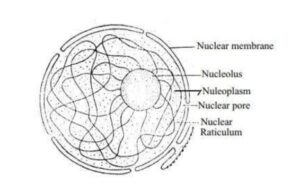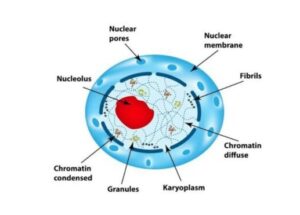Exploring the Nucleus: The Command Center of Life
In the intricate tapestry of biological marvels, the nucleus stands as a central figure, orchestrating a symphony of cellular activities. This enigmatic organelle is more than just a singular entity; it wears different hats depending on the context. Let’s embark on a journey to uncover the diverse roles and significance of the nucleus in various scientific realms.
- Mastering CBSE Class 10 Science: Utilizing Previous Year Question Papers PDF
- CBSE Class 10 Math Previous Year Question Papers PDF
- Exploring Class 6 Math Model Activity Task Part 4: Solutions and Insights
- Cordova Smart Class Software: Transformative Learning Solutions
The Cell Nucleus: The Maestro of Cellular Symphony
In the realm of cell biology, the nucleus takes the spotlight as a membrane-bound organelle. It cradles the cell’s genetic treasure, DNA, within its protective embrace. This DNA isn’t just a mere archive; it’s the blueprint of life itself. The nucleus acts as a diligent conductor, regulating gene expression and guiding the orchestra of cellular functions. Without the nucleus, a eukaryotic cell would be like a ship without a captain, adrift in the sea of chaos.

Atomic Nucleus: The Heart of Matter
Switching gears to the world of atomic physics, the nucleus assumes a different identity. Here, it is the core of an atom, comprising protons and neutrons, and bearing nearly all of the atom’s mass. Electrons pirouette around this nucleus in specific energy levels, creating the dance of chemistry and physics that we observe in our everyday lives. It’s the nucleus that holds the secrets of an element’s identity, defining its atomic number and properties.
Stellar Nucleus: Cosmic Ices and Dust
Venturing into the cosmic expanse of astronomy, we encounter the stellar nucleus. Here, the term “nucleus” refers to the heart of a comet, a celestial wanderer composed of ice, dust, and other celestial debris. As comets approach the blazing embrace of the Sun, the nucleus transforms into a fleeting masterpiece, vaporizing and creating the iconic comet’s tail. It’s a reminder that even in the depths of space, nuclei play their part in the grand cosmic ballet.
Nuclear Physics
In the realm of nuclear physics, the nucleus is the star of the show. Researchers peer deep into its mysteries, studying the behaviour of subatomic particles within atomic nuclei, exploring nuclear reactions, and unravelling the enigmatic properties of these tiny yet mighty cores. It’s a world of quarks, gluons, and the fundamental forces that shape our universe.
Figurative Nucleus: The Heart of Matters Beyond Science
Beyond the scientific domains, the “nucleus” takes on a figurative mantle. It symbolizes the core or central essence of something significant. In a community, it might denote a group of influential individuals who serve as the guiding force. In these contexts, the nucleus is a metaphorical lodestar, guiding endeavours and decisions.
The Nucleus in Biology
Diving deeper into the biological realm, the nucleus reveals itself as a marvel within the microscopic world of cells. It resides within a cell, sheltered by a double-layered nuclear membrane, and is the storehouse of genetic information. Nucleoli, tiny bodies within the nucleus, add to its complexity. Suspended within the nucleoplasm, it orchestrates the cellular symphony of growth, metabolism, and replication.
The Function of Nucleus
The nucleus, nestled within eukaryotic cells, dons many hats and serves several critical functions:

- DNA Storage and Protection: At its core, the nucleus safeguards the cell’s genetic code, DNA, and the recipe book for life itself.
- Transcription: Within its confines, DNA transforms into RNA, a critical step in protein synthesis.
- Gene Expression Regulation: The nucleus finely tunes gene expression, determining which genes are active and which remain dormant.
- Ribosome Production: The nucleolus, a nucleus substructure, assembles ribosomal RNA, vital for protein synthesis.
- Nuclear Pore Complexes: The nuclear envelope, housing the nucleus, controls the selective exchange of molecules between the nucleus and cytoplasm.
- Cell Cycle Control: It regulates key processes during the cell cycle, ensuring proper replication and division.
- Storage of Genetic Information: Besides DNA, the nucleus may hold other genetic elements and proteins, essential for DNA regulation.
- Response to Stress: In times of cellular distress, the nucleus orchestrates repair mechanisms or, in extreme cases, triggers programmed cell death.
The Cell Nucleus: A Singular Sight
Within the intricate landscape of a eukaryotic cell, the nucleus stands as a singular sight, a hub of genetic activity, and the epicentre of cellular governance. It stores, protects, and regulates the essential code of life, ensuring the harmonious functioning of the cell.
Chromosomes, Genes, and DNA: The Symphony of Genetics
To understand the nucleus, we must unravel the interplay of chromosomes, genes, and DNA:
Chromosomes: These threadlike structures, composed of DNA and proteins, ferry genetic information within the nucleus. Humans boast 46 chromosomes, shaping our unique genetic identity.
Genes: The foundations of our biology, genes contain instructions for protein synthesis and dictate our physical traits, such as eye colour. We inherit these genes from our parents, creating our individual genetic tapestry.
DNA: Deoxyribonucleic acid, DNA, resides in every cell’s nucleus, housing our genetic code. Its language consists of four chemical bases—Adenine, Cytosine, Thymine, and Guanine—arranged in intricate codes, forming the blueprint of life.
The Nexus of Life: Genes, DNA, and Chromosomes
In a mesmerizing dance, genes, DNA, and chromosomes collaborate to sculpt our bodies and personalities. Chromosomes ferry DNA, DNA encodes genes, and genes dictate the orchestra of our existence. Your genetic manual passed down from your parents, orchestrates the composition of your being, from the colour of your eyes to the intricacies of your biology.
The Nucleus: Key Roles in Cellular Life
The nucleus is no mere spectator; it plays pivotal roles in the cellular saga:
- DNA Guardian: Safeguarding the cell’s DNA, it regulates growth, multiplication, and replication.
- Metabolic Conductor: The nucleus orchestrates enzyme synthesis, shaping the cell’s metabolism.
- Transcription Maestro: Within its confines, messenger RNA for protein synthesis takes center stage.
- Genetic Courier: The nucleus facilitates the exchange of hereditary molecules, RNA and DNA, with the rest of the cell.
- Chromosome Organizer: During cell division, it choreographs chromatins into the elegant formations of chromosomes.
- Ribosomal Workshop: The nucleolus, nested within, crafts the essential ribosomes.
- Selective Transporter: The nucleus, through its nuclear pores, selectively transports regulatory elements and energy molecules.
- What is Bar Magnet Uses in Laboratory
- Mitochondria Diagram, Function, Structure for Class 9
In conclusion, the nucleus, with its multifaceted roles, is a linchpin in the grand tapestry of life. From the microcosm of cells to the vast cosmos, its presence and functions are a testament to the intricate harmony of the universe.
